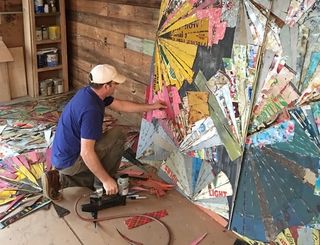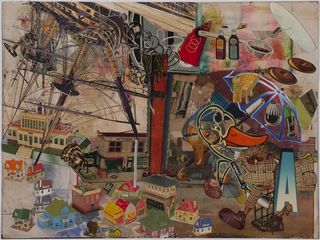Creativity
Inside the Mind of Lance Letscher
Dissecting the genius of a collage artist who wants to take you to fairyland.
Posted November 20, 2017
At first glance, the work of collage artist Lance Letscher may look whimsical, like we're following a pied piper to magical places. He layers paper cuttings and colors and mosaics, and creates a visual trumpet call into Imaginationland. While his work may appear fanciful, it also shouts depth and pain. Somehow, this artist has harnessed the trauma of life into a prolific body of work. Perhaps his inspiration has helped him overcome obstacles, including an absentee mother and the suicide of his father. His life has been carefully documented in Sandra Adair's film, The Secret Life of Lance Letscher. Here is a precursor into his work.
Your childhood seemed pretty dysfunctional, but you are a supremely functional adult. Do you have any insight as to why?

I have had the lucky break of finding and working with a very gifted psychiatrist. She was able to identify a genetic abnormality that produced a proclivity toward depression and anxiety. When she was able to recognize this, she was able to design a highly effective medication regime, and I was able to feel less dysfunctional, most of the time.
Do you believe the cultural trope that depression and black moods can feed creativity?
I think that sometimes the two can go hand in hand; there are countless examples. Even to the degree that one could infer that mental illness sharpens or drives creativity in some way.
My own experience is that dysfunctionality clouds the mind and weakens the body. At a certain point past neurosis and near full-on psychosis, impairment becomes too profound to allow creativity.
Do you feel like you face mortality in your work?
Very much so. Seven years ago, my father committed suicide. I was okay for three or four months before I started to be subjected to pretty profound emotional and physiological shock waves.
I kind of had some sort of protracted nervous breakdown that lasted at least five years, maybe a little more.
This profoundly affected the work. It became darker and more expressionistic for a time. Manic and even alienating for the viewer. I had a kind of dry period during it all; sales fell off, and people long familiar with my work were somewhat perplexed or pushed away by it.
Truthfully, it was that way until my doctor was able to fine-tune my medications about a year ago.
Has this fine-tuning changed your productivity and, in turn, sales?

My use of color has leapfrogged and has become a primary focus while in the studio, creativity and productivity have both improved, and yes, sales have improved as a result of the changes in the work.
I think for a while my work was manic and somewhat dark in tone, because of my manic and dark mental landscape. Now that it is less that way, the mood in my work has lightened, and the formal qualities, composition, use of space, and in particular, the use of color have improved dramatically.
Do you have fears, blocks, or dry periods that set you back?
I worked for another artist for 11 years as a printmaker. I designed multi-plate color etchings, monotypes, and lithographs. Through this experience, I learned to work every day whether I felt inspired or not.
Also, I think about my work all the time. I am very privileged and grateful for the ability and capacity to do my work. I feel very energized when I get to the studio in the morning.
Does your subconscious do some of your work for you?

Yes, most definitely. Especially when actually working. People talk about a “zone” or being in a zone when they work. I think in my case this zone is a region somewhere between a quieting of the mind and the opening of a relatively open track from the subconscious that informs the conscious mind. Not quite a dream state, because I am awake and aware of the work I am doing, but most of the choices I make or the decision-making that goes on is intuitive, opportunistic, and second nature. Not pre-planned or tied to a preconceived concept.
Usually, I start moving my hands and arranging my materials at 8 or 9 a.m., and the next thing I know, it's 3 p.m. and time for coffee.
It's that kind of work.
Your work seems to transition inflows, at least that is the feeling one gets from the film. If you can, please explain some of the transitions?
The work is generally informed by whatever piece I am working on at any given time. The work drives and inspires the next one. Also, I have a set of antenna that is always on the lookout for new themes or ways of working.
I think the other facet of this process is a sort of opportunism. When something new starts to develop by accident or serendipity, I grab hold of it and try to push it.
Do you ever hate what you have produced?
Yes, there is a phase that pops up now and then when a collage is not going well that causes me to get irritated, impatient, or angry. Under those circumstances, I tend to work harder and channel the negative mindset until I fix or resolve the problem.
How exactly do you channel a negative mindset?
I feel a little irritated and impatient sometimes, but as I become aware of that mood creeping in, I also feel a spike in motivation and the will to consciously exercise my patience. Take a few deep breaths or a short break, and then come back and hit it harder.
What artist, writer, or other creative do you admire? And how does he or she inform your work?
I’ve been reading Henri Michaux a lot lately. His The Major Ordeals of the Mind, and the Countless Minor Ones, as well as Miserable Miracle, have had a big impact on my current work.
My patron saint is Vincent van Gogh, though. We have visited the Van Gogh Museum twice (once this year). I also have a book of his letters that is one of my most important books. I am inspired by his use of color, and also the fascinating parallels evident in his times of illness and the more radical and beautiful painting that he produced under that duress.




